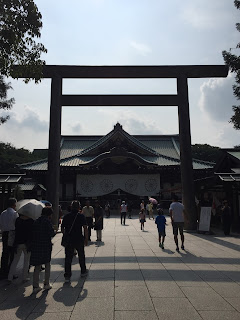Why, long time no see everyone! It has been a while since I've written. After my mom headed back to the US (just in time to join my brother and dad on the multi-day trip back to college) I returned back to the daily work grind and spent my next few off days taking care of "adult" business like paying bills and grocery shopping and binge watching Outlander online.
I did write a cool travel article for Time Out Tokyo though which you can read, in a shameless plug, HERE!
However, at some point after returning to "normalcy" I had to have some proper fun again so today I went to Glitch Coffee & Roasters (hinthint expect to hear more about this later) and the surrounding Jinbocho area.
Glitch Coffee & Roasters was low-key super cool. For [insert surprise reason here] I was able to talk with the shop's founder and current manager, Kiyokazu Suzuki, about his coffee policy and Glitch in general. He also ran a small coffee cupping for us:
Cupping is basically the coffee equivalent of a wine tasting. Usually when you do a cupping you evaluate upwards of 10 types of coffee at a time, but for this mini-cupping we just did four: an Ethiopia Guji Gigesa, Kenya Karinga AA, Guatemala Las Lomas, and another coffee from the Alaka region of Ethiopia.
The cupping process itself is actually fairly simple:
1. First you sniff the dry grounds in order to get a sense of their aroma.
2. Then you pour hot water over the grounds and let it sit for about four minutes, scraping off the slight foam that develops over the top.
3. Then you take a spoonful of each coffee and slurp it so the coffee spreads over your tongue, hard palate, and soft palate and throughout your mouth, just like you are supposed to "swish and spit" when you taste wine.
4. Finally, you evaluate the coffee based on (traditionally) the Specialty Coffee Association of America's criteria. For those with interest here's a really detailed description from the SCAA's website.
Even for the inexperienced palate like mine it's ridiculous how much difference there is between the varieties of coffee. Suzuki described the Kenya AA coffee as tasting "like tomato juice" versus the Ethiopia Guji Gigesa that had a "strawberry" flavor and when you compare the two it's like night and day. The terroir of the coffee, the roasting process, and even the pour-over itself can all impact the flavor so there truly is infinite variation to be found in the world of coffee. It's just one of the reasons Japanese coffee culture has continued to intrigue me even after I've finished my thesis.
Here's my cup of coffee with a yummy almond croissant:
And here's Glitch's super snazzy, super shiny in-house roaster:
They also have a "share roaster" program where stores that don't have their own coffee roasters can come in to roast beans and experiment to develop their own skills and flavor profile, which I think is an amazing way to encourage up-and-coming stores and to bring coffee back from the coffee giants of Starbucks and Dotour and back into the hands of independent shops.
From Glitch I decided to wander around the Jinbocho area which is known for its hundreds of used bookstores. Some sell true rarities and antiques, some specialize in a certain topic or in foreign books, and some are just your "average" neighborhood bookstore:
As I was walking around Jinbocho, I realized that I was only a fifteen minute walk away from the arguably infamous Yasukuni Shrine. For those of you who don't know, Yasukuni Shrine is where all of Japan's war dead are commemorated and deified including some A-class war criminals from WW2. As such, every time there's an official visit to the shrine by the Prime Minister or the Emperor (or even when there isn't) there's often international outcry about Japan's war crimes and their lack of public, international repentance and apology.
Here's the main tori-i (shinto gate) leading up to the shrine:
Usually I quite like Shinto shrines. I find them peaceful, welcoming, and even a little bit feminine. Yasukuni Shrine was, however, more than a little unsettling. Much of it had to do with this main tori-i, I think. It's truly massive and rather than wood it's made of metal. The colossal size combined with the rust-stains reminded me of old blood. Likely it was my own imagination, but I felt a little weird shiver as I walked through and never really felt at home on the complex. I'm sure I'm just projecting onto the space, but I don't think I'll be returning anytime soon. No one else seemed to have any problems with it; on the contrary I saw lots of families with children going to pray so it must have just been me.
Here's one last look at the main shrine building with another (smaller) tori-i just before it.
Tomorrow I technically have work but it's a night shift (10p-7a) so I'll have to try and sleep during the afternoon before work (and, yes, I have the day after that off so I don't have to work 24 hours in a row, which is certainly illegal in any case). I've slowly been (truly) getting used to my job and can now do a variety of different things. I know it's long overdue but there will be a work-themed explanatory post upcoming, I promise! Until then, have a cup of coffee for me.







I'm so intrigued by the coffee's popularity (and the detail of the interest) in Japan. I did take a look at your article in time out! Also love the "share roaster" idea... support small business! Sending overseas love to you xoxo!
ReplyDeleteDelete "the" before "coffee" ??? xo
Delete